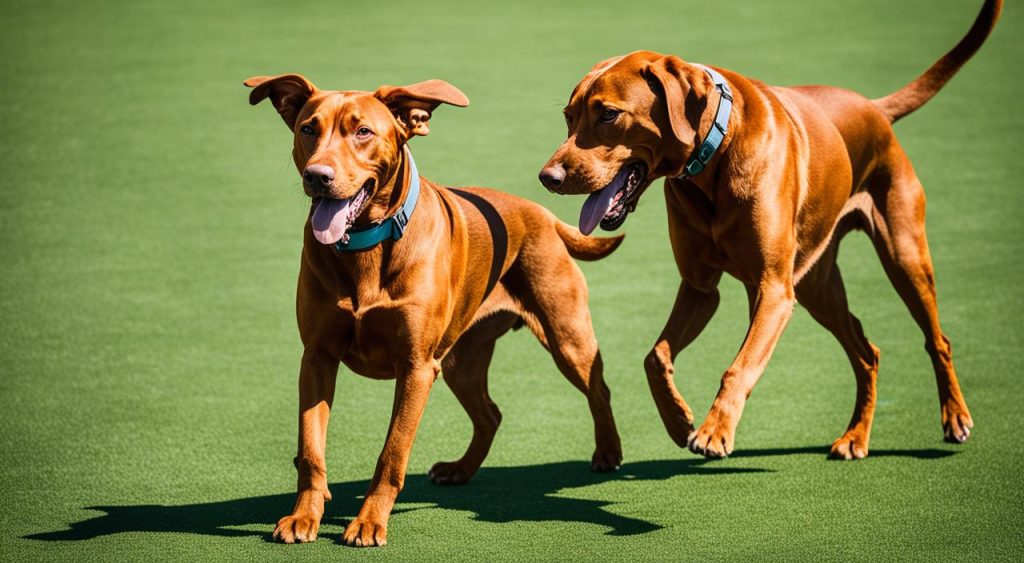When it comes to canine companionship, you may wonder how Vizslas, a popular breed known for their energetic and affectionate nature, interact with other dogs. Are they social butterflies or do they prefer a more solo lifestyle? Let’s delve into the topic of Vizslas and their compatibility with other dogs.
Vizslas are generally friendly and get along well with other dogs. Their social nature and love for attention and interaction make them eager to make new friends in the doggie world. However, like humans, individual Vizslas may have different temperaments and experiences, so it’s important to introduce them to other dogs gradually and monitor their behavior.
Proper socialization from a young age is key to ensure that Vizslas grow up to be well-adjusted and friendly towards other canines. By exposing them to different dogs, environments, and situations during their developmental stages, Vizslas can learn proper play behavior and canine communication. This early socialization helps them develop good social skills with their furry counterparts.
It’s essential to note that Vizslas have a loyal and affectionate temperament. They form deep bonds with their owners and are often referred to as “velcro” dogs as they love to stick close to their humans. With their social nature, Vizslas usually have a friendly and playful demeanor with other dogs, enhancing their compatibility.
However, their behavior with other dogs can be influenced by their early socialization experiences and individual personalities. Some Vizslas may be more reserved or cautious around unfamiliar dogs, while others thrive in a pack-like environment.
Overall, while Vizslas generally do well with other dogs, it’s important to ensure proper socialization, training, and supervision to foster positive interactions. By providing them with positive experiences and interactions with other dogs, you can help your Vizsla develop good social skills and promote a harmonious coexistence in the canine community.
Key Takeaways:
- Vizslas are generally friendly and get along well with other dogs.
- Proper socialization from a young age is important to ensure positive interactions.
- Individual Vizslas may have different temperaments and experiences, so gradual introductions and monitoring are essential.
- Vizslas have a loyal and affectionate temperament and are often referred to as “velcro” dogs.
- Training and supervision are crucial to promote a harmonious coexistence with other dogs.
Vizsla Temperament: The Heart of the Matter
Vizslas are beloved for their loyal and affectionate temperament. They have a natural inclination to form deep bonds with their owners, earning them the nickname “velcro” dogs. These energetic and social canines prefer to be close to their humans, seeking companionship and constant interaction.
When it comes to their behavior around other dogs, Vizslas usually exhibit a friendly and playful demeanor. Their social nature allows them to easily engage with their furry counterparts, making them a great choice for households with multiple pets. However, as with any dog, their behavior with other dogs can be influenced by their early socialization experiences and individual personalities.
Vizsla Behavior with Fellow Canines
When it comes to interacting with other dogs, Vizslas are known for their friendly and playful nature. They enjoy the company of other canines and are often eager to engage in social activities. However, their behavior around other dogs can vary depending on their early socialization experiences.
Proper socialization plays a crucial role in shaping their behavior. Vizslas that are exposed to various dogs, environments, and situations as puppies are more likely to develop good social skills and be well-adjusted around other canines. Regular exposure to different dogs helps them learn proper play behavior and understand canine communication cues.
It’s important to note that individual Vizslas may have different temperaments and experiences. Some Vizslas may be more reserved or cautious around unfamiliar dogs, while others may be more outgoing and social. If you have a Vizsla, it’s essential to introduce them to other dogs gradually and monitor their behavior to ensure positive interactions.
Vizsla’s Pack Mentality
Due to their hunting background, Vizslas have a natural pack mentality. They often thrive in households with multiple dogs and see other canines as part of their “tribe”.
“Vizslas have a strong instinct to be part of a pack,” says Dr. Sarah Johnson, a canine behavior specialist. “They enjoy the companionship and social interaction with other dogs.”
However, this pack mentality can sometimes lead to territorial or dominant behaviors, especially if a Vizsla feels their position in the pack is threatened.
To ensure a harmonious coexistence with other dogs, it is important to establish proper leadership and hierarchy within the pack. This can be achieved through consistent training, setting boundaries, and providing positive reinforcement.
“A confident and assertive pack leader is essential for Vizslas to feel secure and understand their place in the pack,” advises Dr. Johnson. “This helps prevent any issues that may arise from their pack mentality.”
By establishing your role as the pack leader, you can help mitigate any potential dominance or territorial behaviors and create a peaceful and cohesive environment for your Vizsla and other dogs.
Training Vizslas with Other Pets
When it comes to introducing your Vizsla to other pets, such as cats or smaller animals, proper training and socialization are key. Vizslas are generally good with other dogs, but it’s important to ensure positive interactions with all types of animals to teach them appropriate behavior.
Vizsla socialization should begin at an early age to help your dog become comfortable and confident around other pets. Start by slowly introducing your Vizsla to different animals in controlled environments. Monitor their reactions and behavior closely, and provide positive reinforcement for calm and friendly interactions.
Vizsla temperament with dogs plays a crucial role in their behavior around other pets. Their friendly and playful nature often extends to different species, but individual differences may exist. Consistency is key in training your Vizsla to behave appropriately with other pets, reinforcing positive behavior and redirecting any overly excitable or aggressive tendencies.
“Positive interactions and associations with other animals are important for Vizslas to learn how to behave appropriately.”
Positive reinforcement methods such as treats, praise, and play can be effective tools in ensuring that your Vizsla has positive experiences and interactions with other pets. By associating good behavior with rewards, you can shape their responses and help them develop good social skills.
Remember, every Vizsla is unique, and their behavior around other pets may vary. It’s essential to provide ongoing training and socialization opportunities to continue reinforcing positive behaviors. With patience, consistency, and a focus on positive reinforcement, you can help your Vizsla develop good social skills and enjoy harmonious relationships with other pets.
The Vizsla and Other Animals: Beyond Canine Companionship
When it comes to other animals, Vizslas can exhibit different behaviors and interactions. Their hunting instincts may trigger a strong prey drive towards birds, so it’s important to exercise caution when introducing them to birds or other small animals.
“Vizslas, with their natural hunting instincts, may be inclined to chase and potentially harm birds or small animals. It is crucial to supervise their interactions and ensure the safety of all animals involved.”
Vizslas’ compatibility with cats can vary depending on their individual personalities and experiences. “It is recommended to introduce Vizslas and cats gradually and under supervision to assess their compatibility and prevent any potential conflicts.” Proper introductions, along with ongoing observation and management, can help foster positive relationships between Vizslas and cats.
“When it comes to smaller pets like hamsters or rabbits, it’s crucial to prioritize their safety and separate them from Vizslas entirely due to the potential risk of injury or harm.”
Overall, while Vizslas are generally good with other dogs, their interactions with other animals require careful consideration and management. By being mindful of their prey drive and introducing them to other animals in a controlled manner, you can promote a harmonious coexistence between your Vizsla and other pets.
Conclusion
In conclusion, Vizslas are known for their good temperament and compatibility with other dogs. With proper socialization and training from a young age, Vizslas can develop positive interactions with their canine counterparts. While individual temperaments may vary, Vizslas’ social nature and love for attention generally make them friendly towards other dogs.
Introducing Vizslas to other dogs in a controlled and supervised manner is important to ensure a harmonious coexistence. Monitoring their behavior during these interactions can help identify any potential issues and address them appropriately. With their natural pack mentality, Vizslas often thrive in households with multiple dogs, viewing other canines as part of their “tribe”.
To ensure a successful relationship between Vizslas and other dogs, it is crucial to establish proper leadership and hierarchy within the pack. This helps prevent territorial or dominant behaviors from emerging. Early socialization, positive reinforcement, and consistency in training can all contribute to Vizslas’ compatibility and positive interactions with other dogs.





